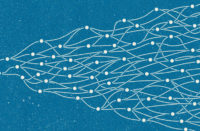
A work that is counted as a break through in music theory may not be one that is actually played very often. John Cage’s groundbreaking 4′ 33″, for example, definitely has a place in the history books even if there are exceedingly few people that has actually heard the work performed. Kim Cascone’s Residualism can also be seen as more theoretically than practically interesting. The cover sports the following: “All content was created using a custom MAX/MSP
patch designed by Kim Cascone.”
MSP is a program language. MAX is a sound program that can
act upon patches written in MSP. So the quote can be taken to mean that Kim Cascone has created a program that has then created the contents of the CD. It’s called generative music, music that is generated by a computer program, computer programs that can create new music all the time.
The musician’s role is reduced to writing code. In the future perhaps the most celebrated musicians are those that write the programs that create the most exciting music, and we will
wonder how people once could listen to one and the same piece of music over and over again (yeah, sure that’s how it’ll be).
So far the theory behind Residualism, what does the result sound like? The record consists of a single 41 minute tune, which resembles ambient music the closest. Light tones travels up and down the scale, small plippety-plop sounds that could be water drops or something boiling, sounds like air bubbles in an underwater film. Everything has an inescapable synthetic quality, though. From a theoretic viewpoint the work is undeniably interesting, but more pragmatically I have heard significantly better albums in the same vein, and I won’t be listening to Residualism many times. It would have been much more fun if the disc had contained a CD-Rom partition with the MAX/MSP patch in question.























